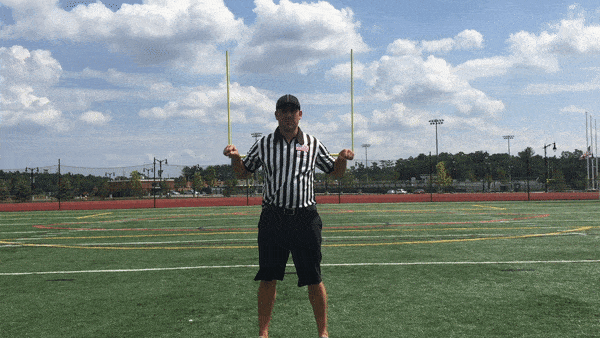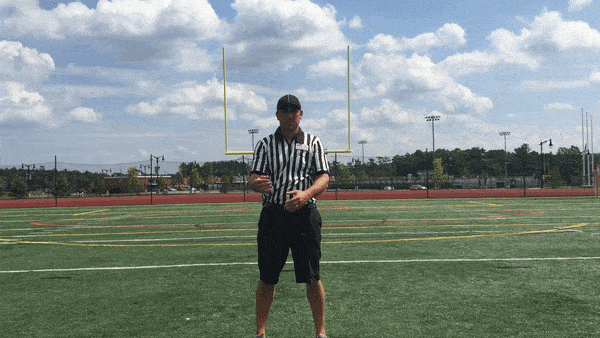Penalty flags in football can be seen throughout the entire game. The referee is in charge of throwing the yellow flags on the ground. What do these yellow flags mean?
Yellow flags in football are thrown when one or both teams commit a penalty. Each penalty results in a loss of yardage for the team at fault.
This article will look at what a flag is in football and how teams can avoid penalties.
Penalty Flag In Football
On October 17, 1941, the first penalty flag was thrown at a game between Youngstown College and Oklahoma City University. This flag thrown was because of holding and brought back a 17 yard touchdown.
In order to maintain fair play, like most sports, football has rules that every play must abide by. Football being a contact sport, means that certain hits and blocks are dangerous and illegal.
Once a player has committed a foul, the referee will throw his yellow flag on the field, indicating a penalty has been committed.
The referee throws penalty flags in football on the ground when they identify a penalty. In American football, it’s common to see a penalty flag lying on the ground every play.
There are three types of penalties in football:
- Pre-snap Penalties
- Post-snap Penalties
- After The Play Penalties
Each type of penalty will yield different results. The smaller penalties will result in a loss of 5 yards, while stricter penalties could result in 15-yard penalties and downs.
A football penalty flag is thrown by the referee, who can be seen wearing a black and white striped shirt. All game officials will wear zebra-striped shirts to stick out away from the players.
Whenever a referee encounters a penalty, it’s their responsibility to throw the flag in the air so everyone can see it, and then identify why it was thrown at the home.
The yellow flag is made up of yellow cloth and rock or hard material inside to act as a weight. Referees have multiple flags that are tucked into their hips.
Different penalties require stoppage in play, while other penalties require the play to continue, and once the play is over, the referees will assess the penalty.
Increase Your Football IQ
Why spend hours on Google and YouTube trying to learn football yourself? We’ve created a simple guide to help make you the smartest person in the room.
Pre-Snap Penalty
A pre-snap penalty is when a penalty occurs before the play happens. These penalties often relate to how the offense or defense lines up, movement before the snap, or having too many players on the field.
Pre-snap penalties on offense include:
- False Start
- Illegal Formation
- Illegal Shift
- Delay Of Game
- Too Many Players On The Field
These penalties all resort to small 5-yard penalties, with a replay of the down. These penalties are minor, and the consequences are minor. However, they do impact if the team has a 3rd down.
Offensive players’ cadence, motions, and alignments must be practiced daily to avoid pre-snap penalties on offense.
Pre-snap penalties on defense include:
- Encroachment
- Offsides
- Neutral Zone Infraction
- Too Many Players On The Field
We’ve broken down the pre-snap penalties in a video here:
Post-Snap Penalty
Post-snap penalties occur after the football has been snapped to the quarterback. The flag will be thrown on the ground near where the penalty occurred. These penalties are more common in football than pre-snap penalties.
These penalties are often due to a lack of technique, poor hand placement, or poor leverage. The result is a penalty that will usually result in a loss of 10 yards.
On offense, some of the post-snap penalties include:
- Block In The Back
- Clipping
- Holding
- Pass Interference
- Illegal Hands To The Face
These penalties all occur after the ball is snapped on offense. As mentioned, these penalties are often a result of bad technique. These penalties will result in a loss of 10 yards.
Post-snap penalties on defense are also a result of poor form. Hand placement is key for defensive players to avoid post-snap penalties. These are some of the penalties:
- Facemask
- Pass Interference
- Holding
- Roughing The Passer
- Illegal Contact
These penalties range from a loss of 5 to 15 yards. Post-snap penalties should be avoided at all costs, as they typically result in an automatic first down, giving the offense a fresh set of downs.
Increase Your Football IQ
Why spend hours on Google and YouTube trying to learn football yourself? We’ve created a simple guide to help make you the smartest person in the room.
After The Play Penalty
After the play is officially ruled down, there is a small window of opportunity to throw a penalty flag. These flags are known as dead ball penalties.
These penalty flags are often thrown because of an unnecessary penalty. This call is known as “unnecessary roughness.”
Unnecessary roughness is when a play hits another player after the play is over. Once the whistle blows, all players must stop what they’re doing and go back to their sides of the ball.
If a player is still making contact after the whistle, the referee will throw the flag, resulting in a 15-yard penalty. Unnecessary roughness calls are often the result of undisciplined players or players that are too aggressive.
These penalties are often dangerous as a late hit can result in serious injury. If a flag is thrown after the play, it can result in the referee’s decision to remove a player from the field.
How To Avoid Football Penalty Flags
To avoid pre-snap penalties, teams must practice stance, start, and cadence.
On offense, having the quarterback consistently practice his cadence with the offense will help prevent false starts.
Defensively, the defensive line should always be watching and reacting off the football. If they watch the receiver or, even worse, listen to the offense’s cadence, there’s a good chance a penalty will soon follow.
To avoid penalties post-snap, users should focus on their footwork, hand placement, and leverage. Post-snap penalties often occur because one of these three items is lacking. This ultimately results in a 10-yard penalty that can set back the offense.
Finally, after the snap, penalties can be solved through discipline. Football penalties can be avoided after the snap by making sure your players are disciplined.
Undisciplined players will often get “after the play” penalties because they’re too aggressive or too angry actually to control their emotions. This will result in flags after the play.
Keep Learning
NFL penalty flags typically slow the game down, as viewers want to see consistent action. College football has less strict rules than the NFL, but a flag may occur just as often.
The first used flags were in a similar construction to what we see nowadays. Flags in football play a large part in the regulation of keeping the game safe.
If you liked learning about flags, we recommend you check out our Beginners Guide To Football below. It can help to vastly improve your Football IQ.
Below are articles to help you learn more about the rules of football.
Rules Of American Football – Beginner’s Guide
Difference Between Legal & Illegal Blocks In Football
Illegal Contact With Wide Receivers Explained
Can A Football Game End On A Penalty?
Football Overtime Rules: NFL Vs. College/High School
Understanding the 5 Yard Contact Rule In The NFL
Learn Offsides, Neutral Zone Infraction, and Encroachment
Complete Guide To Referee Signals In American Football
What Is A Safety In Football? Explained
Penalty flags are important because they help regulate the game of football. Referees will throw penalty flags, so neither team gets an advantage. Penalty flags are at the referee’s discretion.
Oftentimes, referees can miss a call, resulting in a team benefitting from a missed call. We must understand that referees are humans, and they make mistakes.
The team that can avoid the most penalties is often the team that will win. Coaches don’t prepare plays for penalties; they prepare for situations. Negative situations are something that every coach tries to avoid.
Consistent, disciplined teams will win and win for a long time. The perfect example is the New England Patriots. Year after year, they consistently win football games because of their discipline and attention to detail.
No referee is perfect, although they strive to be. Referees are the most important people on a football field, as they help regulate and officiate the football game. Without referees, there is no football.
Let’s keep learning! Our learning center is packed with information regarding techniques, schemes, and more!
If you’re looking for more in-depth breakdowns & coaching resources, visit our coaching resource page here.





